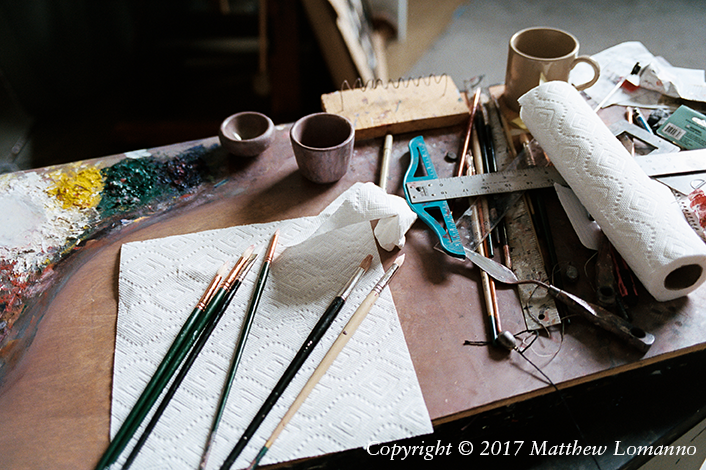Ordered Creation: Life and Art Within an Atelier
Entering the Ingbretson Studio of Drawing and Painting is like entering a monastery: the utter silence of students working in their stalls or reading in the library; the relative darkness, with angular natural light; the rhythm of communal life with a shared meal time; and a general solitude of experience. This space, and the culture inhabiting it, offers thoughtful and reflective work, which, in this former mill building in Manchester, New Hampshire, is orderly, directed, and yet creative.
One comes here to learn specific visual skills that require much time, practice, dedication, and guidance. All these could be achieved individually—by the solitary student under a master—but pursuing them within a tradition of community brings the benefits that many artists need to progress and succeed: support and encouragement by peers, judgment and critique by those same peers, seeing others’ work, learning from advanced students, discussing ideas and difficulties, and cultivating the various kinds of friendship formed after long periods of working together in close proximity. Suggestions and critiques are both clear and honest, as they stem from a shared set of visual and artistic goals, concepts, and vocabulary.
What unifies the enterprise at the Ingbretson Studio is the conviction that learning to see light and form—both in reality and in one’s strokes with pencil and brush—is requisite to practice in the visual arts. Developing those habits demands experience and time, to say nothing of talent and effort. Student artists proceed along the course only as the master sees fit, not according to a prescribed timeline. Such an approach to visual art-making—one that, if it is not a reaction against contemporary art, at least ignores most of the past century—is rare, scattered throughout the world in these studios known as “ateliers.”
Paul Ingbretson has been teaching here for more than three decades. He offers no degrees or certificates, and some students (even when they become teachers themselves) remain under his tutelage. Some have relocated to train here. Their histories and occupations vary: a retired medical doctor, a former art teacher, a current art teacher, a homeschooled musician. Some are here daily, full-time; others attend as work schedules permit. All of them seek a rare and nearly forgotten method of art education.
They come to this place—to Paul—to study the tradition of painting known as “the Boston School.” This tradition, carried along primarily by a master’s instruction and student’s practice, regards learning to see light and its effects first by drawing plaster casts on canvas with charcoal (creating a two-dimensional work from a three-dimensional object). The process is prescribed and orderly: following cast drawings, the student moves to still-life painting, then portraits, and finally figure studies. An advanced student will create the latter three continuously.
Ingbretson’s instruction and discussions inevitably invoke a reference to the Boston School’s past masters and founders: some who have inspired this tradition (Sargent, Vermeer, Monet), others immediately involved (Gammell, Paxton, Hale). This art is “derived from nature,” in Ingbretson’s words, and the work is constantly evaluated for that standard. What is created, however, is not life itself but a visually unified painting, with its own internal relations. That is, life is not confused with art; this is no blind realism or reproduction. Furthermore, the process is not fixed: it offers “guidelines, not rules,” “not a formula, but an ear” for painting. Forming habits of vision and of art is the goal of this education.
Creating this work has its own rhythm and pace: preparing the still life’s objects and background, with an eye towards color, tone, and arrangement; painting the layers to create shapes and tones; and standing back to view the subject and composition, then coming forward to make a mark on the canvas. This last step is repeated thousands of times over the hours of work, moving to and from the painting, seeing the whole while refining the details. The goal, according to Ingbretson, is to create a “unity of a general [visual] impression” (the “hardest part of painting”) via a “simultaneity” of relations such that the viewer understands the whole at once.
Contrasted to other approaches to art education (especially those since the mid-twentieth century), many of which value the artist’s expression over any particular learned techniques, Ingbretson demands a mastery of particular ways of seeing, drawing, and painting that will enable his students to produce anything they wish. How he educates his students is not inconsequential, either: one student remarked that she learned more in one and a half years with him than in four years in her BFA program. Another student, also with a BFA, had left his own teaching position at a high school because he “couldn’t teach them what they needed.” His previous art professors had discouraged and dismissed his desire to learn such a method: “Art has progressed from there,” they said.
All fine art, however, is contemporary, and the world is fortunately large enough to accommodate even a teacher and his students sustaining a traditional method of painting, toiling in a quiet old mill building.
For more photos from the Ingbretson Studio of Drawing and Painting, visit matthewlomanno.com/atelier.
Matthew Lomanno is an editorial and documentary photographer. His work can be seen at www.matthewlomanno.com.











